Accounting Theory Report: Financial Analysis of Woolworths Company
VerifiedAdded on 2020/02/24
|19
|4186
|106
Report
AI Summary
This report provides a comprehensive analysis of the accounting theory applied by Woolworths, an Australian supermarket company. It examines the company's accounting policies and estimates, including the basis of consolidation, cash and cash equivalents, foreign currency considerations, and GST treatment. The report also explores the flexibilities within these policies and compares Woolworths' practices with those of its competitor, Wesfarmers, analyzing their respective financial statements and accounting strategies. Furthermore, the report investigates potential red flags or questionable numbers within Woolworths' annual report, categorizing them according to accounting policies and evaluating the reasons behind these classifications. The analysis extends to a critical evaluation of accounting quality, assessing both policies and estimates to provide a thorough understanding of Woolworths' financial reporting practices.
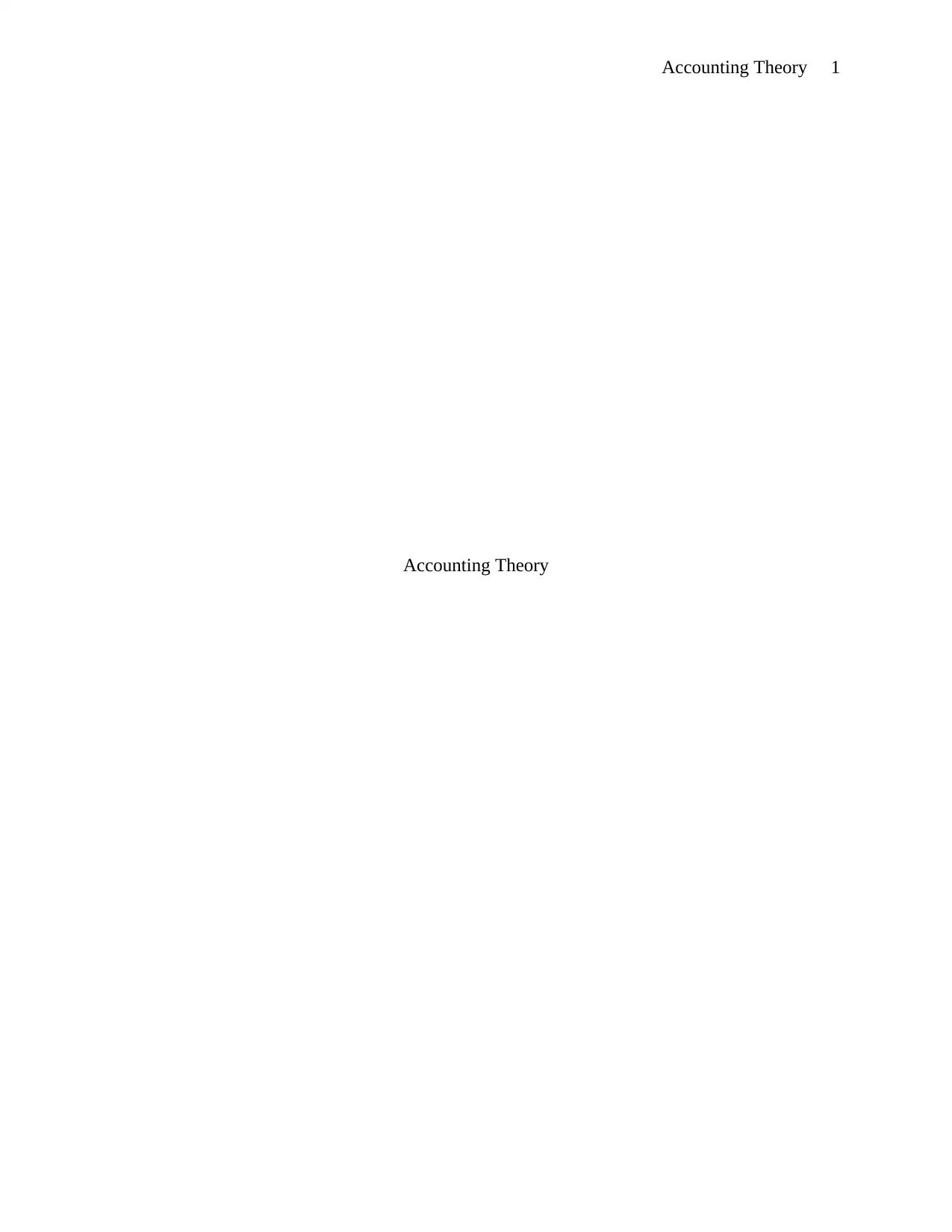
Accounting Theory 1
Accounting Theory
Accounting Theory
Paraphrase This Document
Need a fresh take? Get an instant paraphrase of this document with our AI Paraphraser
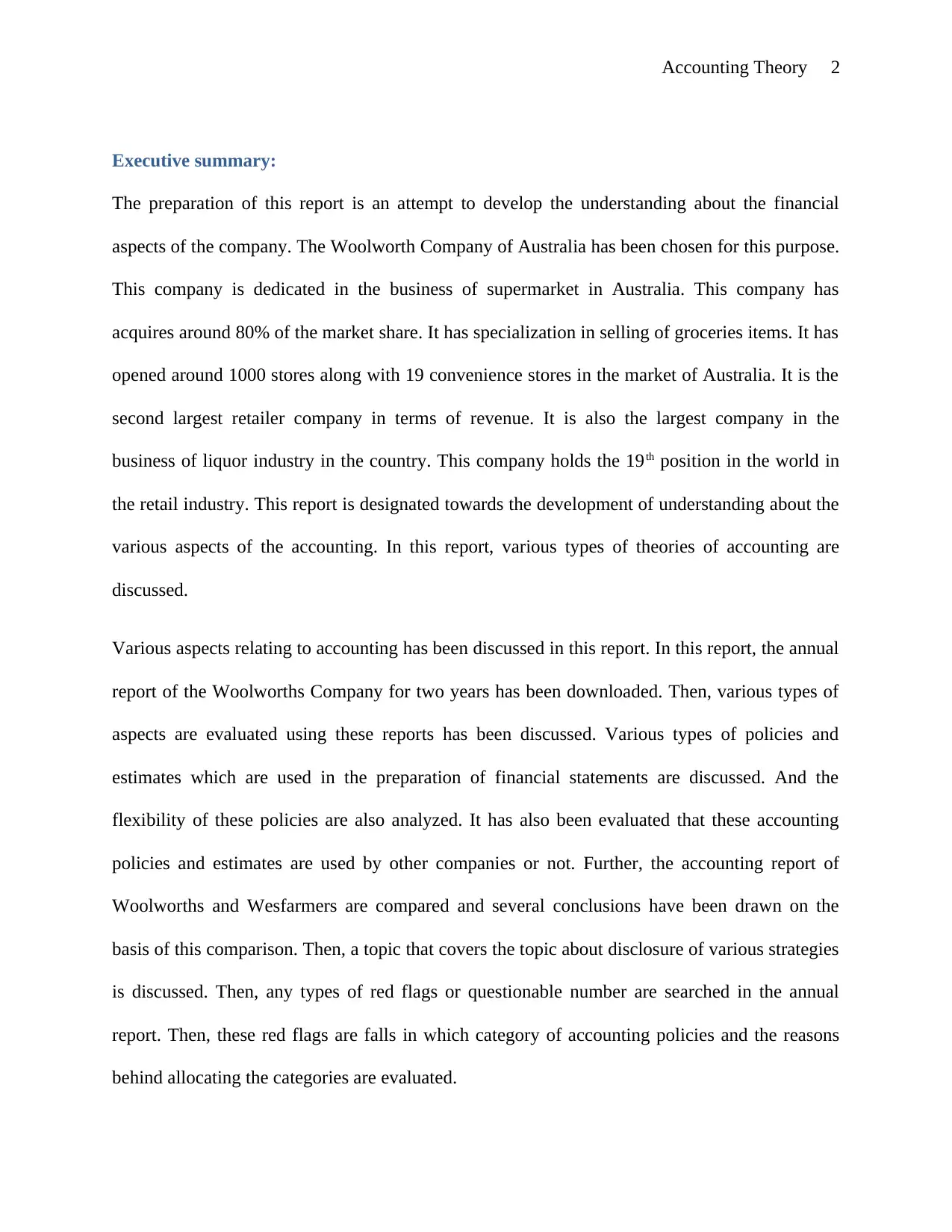
Accounting Theory 2
Executive summary:
The preparation of this report is an attempt to develop the understanding about the financial
aspects of the company. The Woolworth Company of Australia has been chosen for this purpose.
This company is dedicated in the business of supermarket in Australia. This company has
acquires around 80% of the market share. It has specialization in selling of groceries items. It has
opened around 1000 stores along with 19 convenience stores in the market of Australia. It is the
second largest retailer company in terms of revenue. It is also the largest company in the
business of liquor industry in the country. This company holds the 19th position in the world in
the retail industry. This report is designated towards the development of understanding about the
various aspects of the accounting. In this report, various types of theories of accounting are
discussed.
Various aspects relating to accounting has been discussed in this report. In this report, the annual
report of the Woolworths Company for two years has been downloaded. Then, various types of
aspects are evaluated using these reports has been discussed. Various types of policies and
estimates which are used in the preparation of financial statements are discussed. And the
flexibility of these policies are also analyzed. It has also been evaluated that these accounting
policies and estimates are used by other companies or not. Further, the accounting report of
Woolworths and Wesfarmers are compared and several conclusions have been drawn on the
basis of this comparison. Then, a topic that covers the topic about disclosure of various strategies
is discussed. Then, any types of red flags or questionable number are searched in the annual
report. Then, these red flags are falls in which category of accounting policies and the reasons
behind allocating the categories are evaluated.
Executive summary:
The preparation of this report is an attempt to develop the understanding about the financial
aspects of the company. The Woolworth Company of Australia has been chosen for this purpose.
This company is dedicated in the business of supermarket in Australia. This company has
acquires around 80% of the market share. It has specialization in selling of groceries items. It has
opened around 1000 stores along with 19 convenience stores in the market of Australia. It is the
second largest retailer company in terms of revenue. It is also the largest company in the
business of liquor industry in the country. This company holds the 19th position in the world in
the retail industry. This report is designated towards the development of understanding about the
various aspects of the accounting. In this report, various types of theories of accounting are
discussed.
Various aspects relating to accounting has been discussed in this report. In this report, the annual
report of the Woolworths Company for two years has been downloaded. Then, various types of
aspects are evaluated using these reports has been discussed. Various types of policies and
estimates which are used in the preparation of financial statements are discussed. And the
flexibility of these policies are also analyzed. It has also been evaluated that these accounting
policies and estimates are used by other companies or not. Further, the accounting report of
Woolworths and Wesfarmers are compared and several conclusions have been drawn on the
basis of this comparison. Then, a topic that covers the topic about disclosure of various strategies
is discussed. Then, any types of red flags or questionable number are searched in the annual
report. Then, these red flags are falls in which category of accounting policies and the reasons
behind allocating the categories are evaluated.
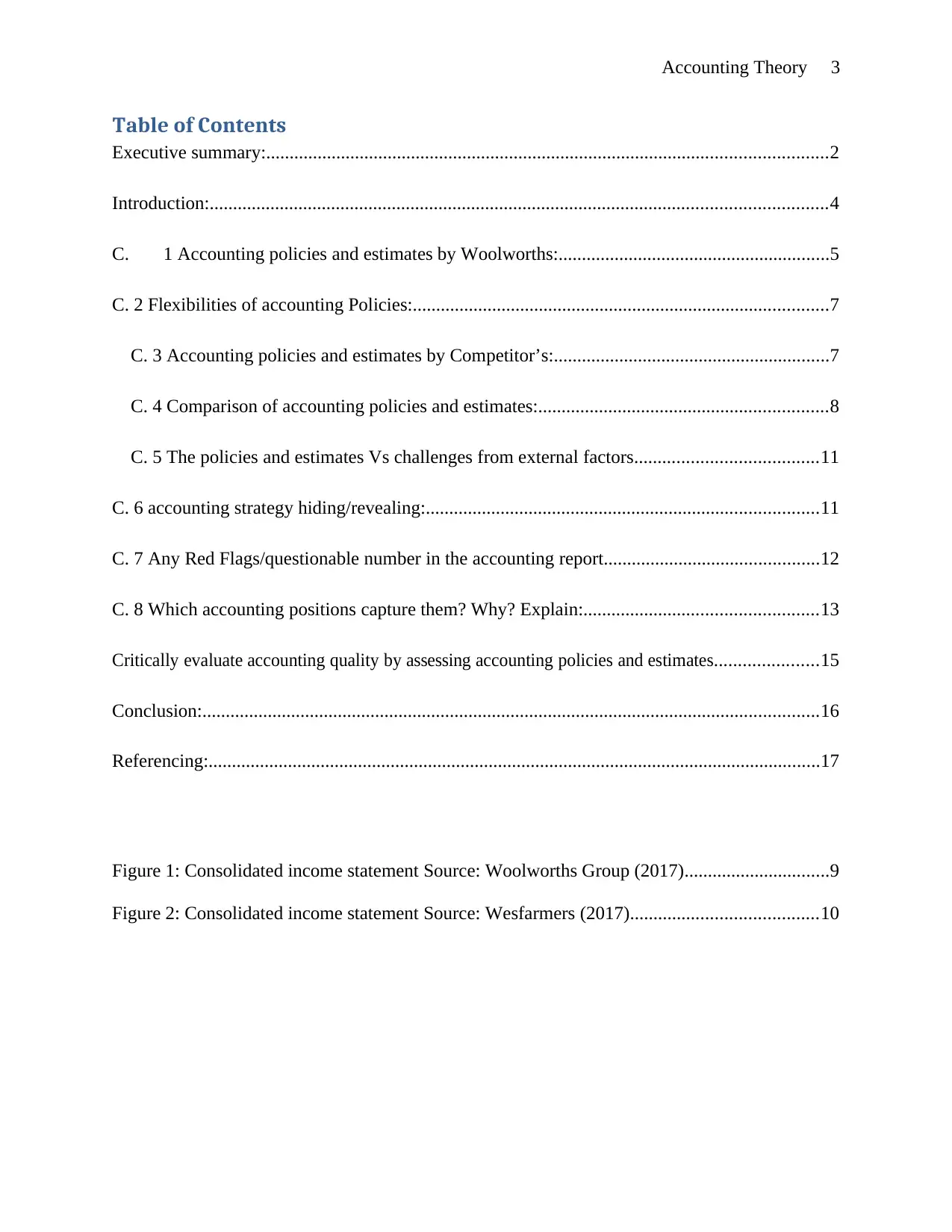
Accounting Theory 3
Table of Contents
Executive summary:........................................................................................................................2
Introduction:....................................................................................................................................4
C. 1 Accounting policies and estimates by Woolworths:..........................................................5
C. 2 Flexibilities of accounting Policies:.........................................................................................7
C. 3 Accounting policies and estimates by Competitor’s:...........................................................7
C. 4 Comparison of accounting policies and estimates:..............................................................8
C. 5 The policies and estimates Vs challenges from external factors.......................................11
C. 6 accounting strategy hiding/revealing:....................................................................................11
C. 7 Any Red Flags/questionable number in the accounting report..............................................12
C. 8 Which accounting positions capture them? Why? Explain:..................................................13
Critically evaluate accounting quality by assessing accounting policies and estimates......................15
Conclusion:....................................................................................................................................16
Referencing:...................................................................................................................................17
Figure 1: Consolidated income statement Source: Woolworths Group (2017)...............................9
Figure 2: Consolidated income statement Source: Wesfarmers (2017)........................................10
Table of Contents
Executive summary:........................................................................................................................2
Introduction:....................................................................................................................................4
C. 1 Accounting policies and estimates by Woolworths:..........................................................5
C. 2 Flexibilities of accounting Policies:.........................................................................................7
C. 3 Accounting policies and estimates by Competitor’s:...........................................................7
C. 4 Comparison of accounting policies and estimates:..............................................................8
C. 5 The policies and estimates Vs challenges from external factors.......................................11
C. 6 accounting strategy hiding/revealing:....................................................................................11
C. 7 Any Red Flags/questionable number in the accounting report..............................................12
C. 8 Which accounting positions capture them? Why? Explain:..................................................13
Critically evaluate accounting quality by assessing accounting policies and estimates......................15
Conclusion:....................................................................................................................................16
Referencing:...................................................................................................................................17
Figure 1: Consolidated income statement Source: Woolworths Group (2017)...............................9
Figure 2: Consolidated income statement Source: Wesfarmers (2017)........................................10
⊘ This is a preview!⊘
Do you want full access?
Subscribe today to unlock all pages.

Trusted by 1+ million students worldwide
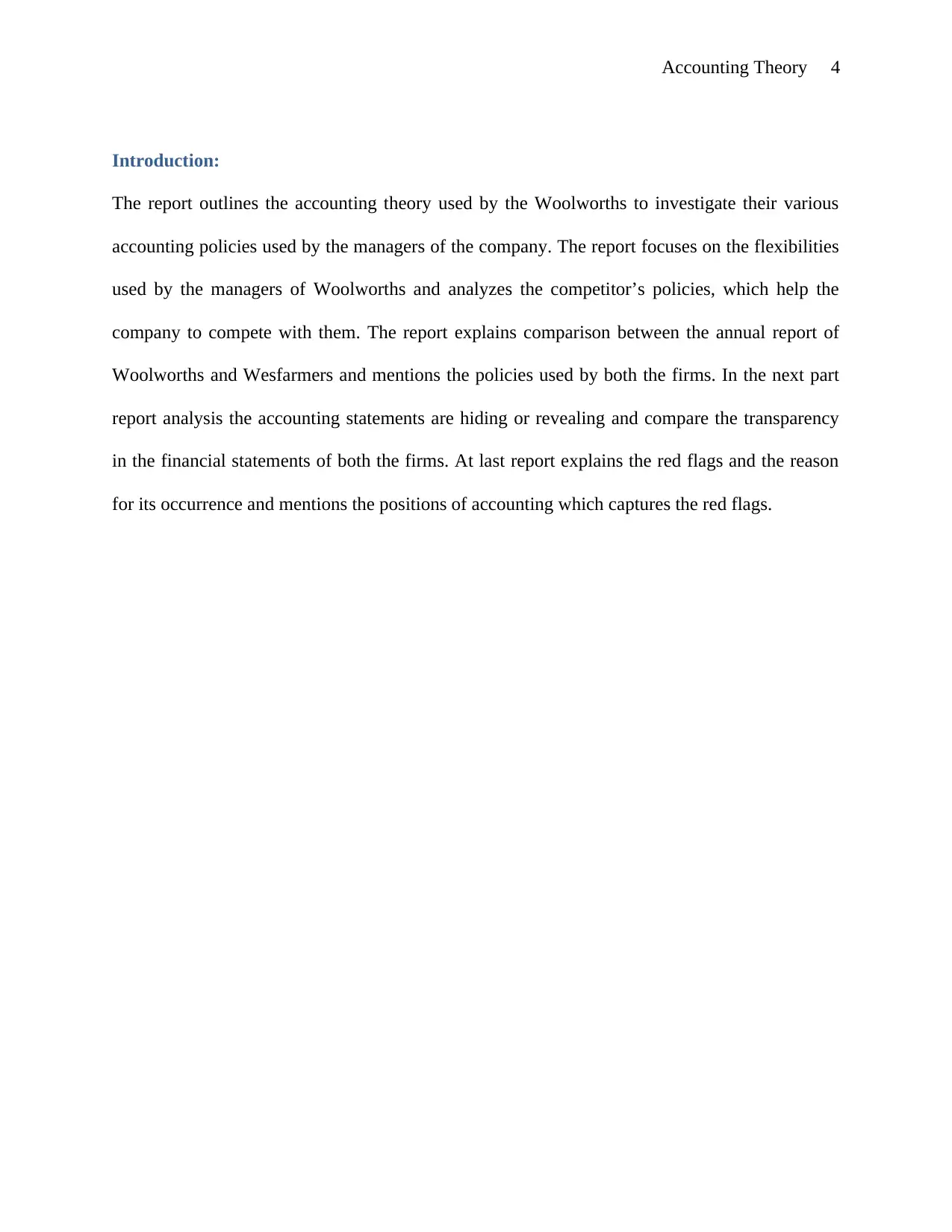
Accounting Theory 4
Introduction:
The report outlines the accounting theory used by the Woolworths to investigate their various
accounting policies used by the managers of the company. The report focuses on the flexibilities
used by the managers of Woolworths and analyzes the competitor’s policies, which help the
company to compete with them. The report explains comparison between the annual report of
Woolworths and Wesfarmers and mentions the policies used by both the firms. In the next part
report analysis the accounting statements are hiding or revealing and compare the transparency
in the financial statements of both the firms. At last report explains the red flags and the reason
for its occurrence and mentions the positions of accounting which captures the red flags.
Introduction:
The report outlines the accounting theory used by the Woolworths to investigate their various
accounting policies used by the managers of the company. The report focuses on the flexibilities
used by the managers of Woolworths and analyzes the competitor’s policies, which help the
company to compete with them. The report explains comparison between the annual report of
Woolworths and Wesfarmers and mentions the policies used by both the firms. In the next part
report analysis the accounting statements are hiding or revealing and compare the transparency
in the financial statements of both the firms. At last report explains the red flags and the reason
for its occurrence and mentions the positions of accounting which captures the red flags.
Paraphrase This Document
Need a fresh take? Get an instant paraphrase of this document with our AI Paraphraser
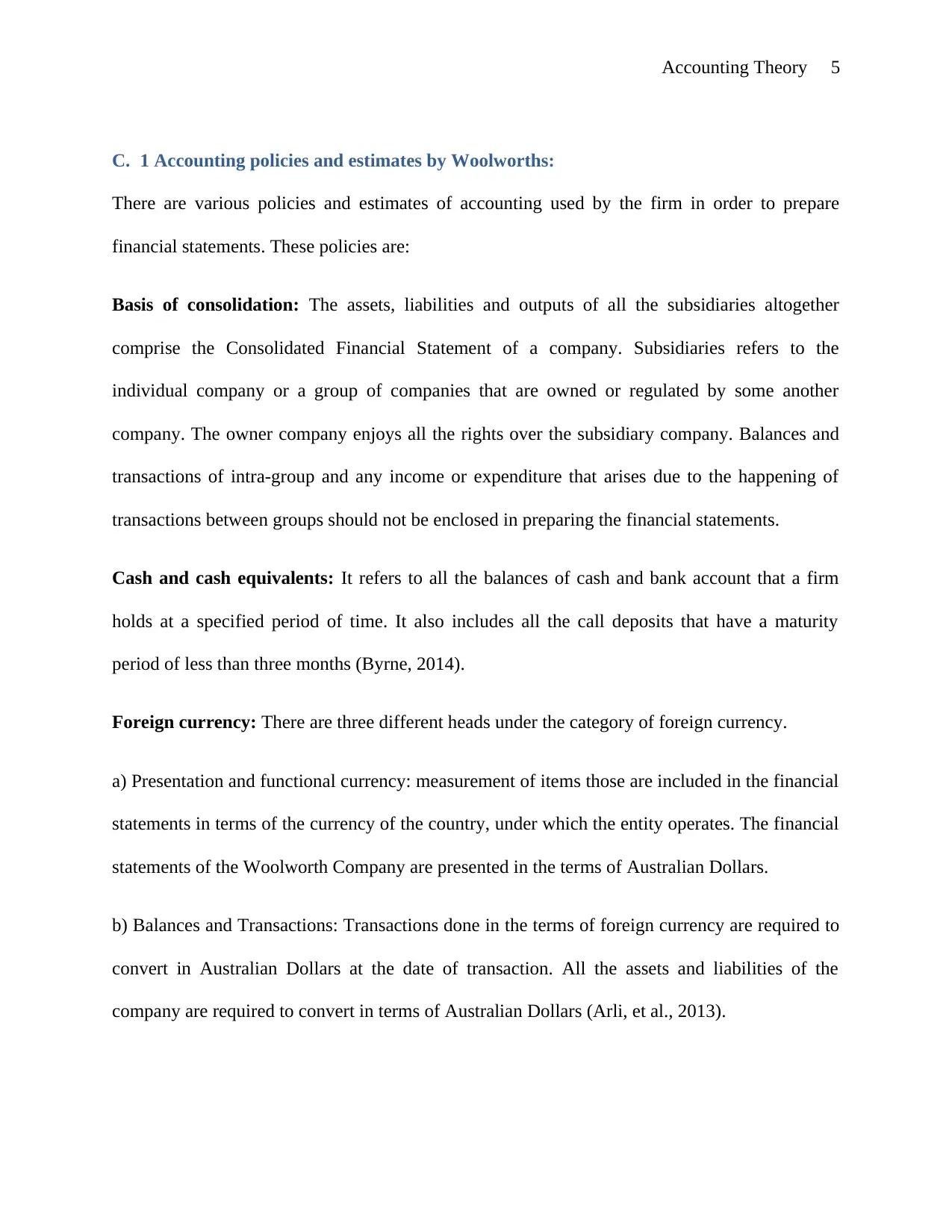
Accounting Theory 5
C. 1 Accounting policies and estimates by Woolworths:
There are various policies and estimates of accounting used by the firm in order to prepare
financial statements. These policies are:
Basis of consolidation: The assets, liabilities and outputs of all the subsidiaries altogether
comprise the Consolidated Financial Statement of a company. Subsidiaries refers to the
individual company or a group of companies that are owned or regulated by some another
company. The owner company enjoys all the rights over the subsidiary company. Balances and
transactions of intra-group and any income or expenditure that arises due to the happening of
transactions between groups should not be enclosed in preparing the financial statements.
Cash and cash equivalents: It refers to all the balances of cash and bank account that a firm
holds at a specified period of time. It also includes all the call deposits that have a maturity
period of less than three months (Byrne, 2014).
Foreign currency: There are three different heads under the category of foreign currency.
a) Presentation and functional currency: measurement of items those are included in the financial
statements in terms of the currency of the country, under which the entity operates. The financial
statements of the Woolworth Company are presented in the terms of Australian Dollars.
b) Balances and Transactions: Transactions done in the terms of foreign currency are required to
convert in Australian Dollars at the date of transaction. All the assets and liabilities of the
company are required to convert in terms of Australian Dollars (Arli, et al., 2013).
C. 1 Accounting policies and estimates by Woolworths:
There are various policies and estimates of accounting used by the firm in order to prepare
financial statements. These policies are:
Basis of consolidation: The assets, liabilities and outputs of all the subsidiaries altogether
comprise the Consolidated Financial Statement of a company. Subsidiaries refers to the
individual company or a group of companies that are owned or regulated by some another
company. The owner company enjoys all the rights over the subsidiary company. Balances and
transactions of intra-group and any income or expenditure that arises due to the happening of
transactions between groups should not be enclosed in preparing the financial statements.
Cash and cash equivalents: It refers to all the balances of cash and bank account that a firm
holds at a specified period of time. It also includes all the call deposits that have a maturity
period of less than three months (Byrne, 2014).
Foreign currency: There are three different heads under the category of foreign currency.
a) Presentation and functional currency: measurement of items those are included in the financial
statements in terms of the currency of the country, under which the entity operates. The financial
statements of the Woolworth Company are presented in the terms of Australian Dollars.
b) Balances and Transactions: Transactions done in the terms of foreign currency are required to
convert in Australian Dollars at the date of transaction. All the assets and liabilities of the
company are required to convert in terms of Australian Dollars (Arli, et al., 2013).
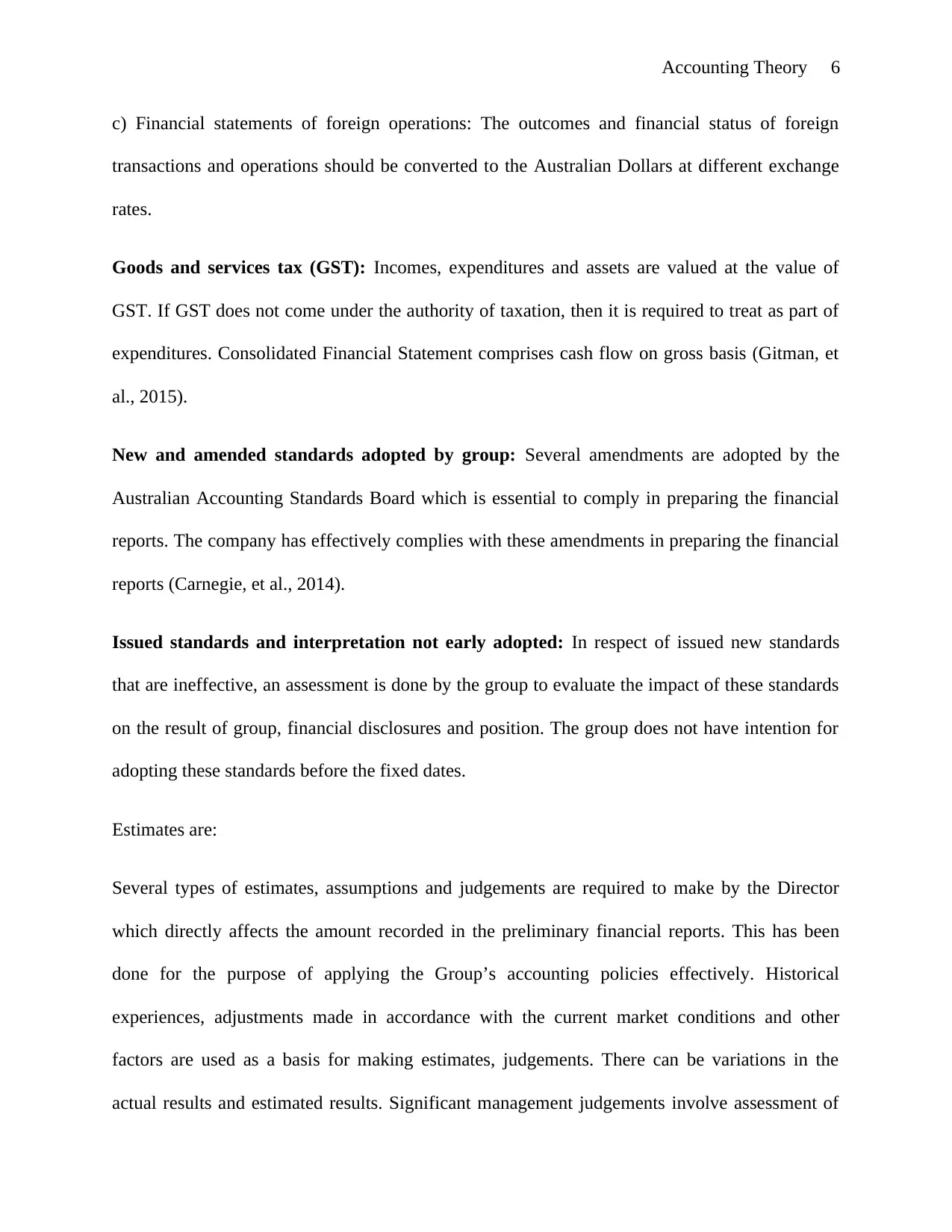
Accounting Theory 6
c) Financial statements of foreign operations: The outcomes and financial status of foreign
transactions and operations should be converted to the Australian Dollars at different exchange
rates.
Goods and services tax (GST): Incomes, expenditures and assets are valued at the value of
GST. If GST does not come under the authority of taxation, then it is required to treat as part of
expenditures. Consolidated Financial Statement comprises cash flow on gross basis (Gitman, et
al., 2015).
New and amended standards adopted by group: Several amendments are adopted by the
Australian Accounting Standards Board which is essential to comply in preparing the financial
reports. The company has effectively complies with these amendments in preparing the financial
reports (Carnegie, et al., 2014).
Issued standards and interpretation not early adopted: In respect of issued new standards
that are ineffective, an assessment is done by the group to evaluate the impact of these standards
on the result of group, financial disclosures and position. The group does not have intention for
adopting these standards before the fixed dates.
Estimates are:
Several types of estimates, assumptions and judgements are required to make by the Director
which directly affects the amount recorded in the preliminary financial reports. This has been
done for the purpose of applying the Group’s accounting policies effectively. Historical
experiences, adjustments made in accordance with the current market conditions and other
factors are used as a basis for making estimates, judgements. There can be variations in the
actual results and estimated results. Significant management judgements involve assessment of
c) Financial statements of foreign operations: The outcomes and financial status of foreign
transactions and operations should be converted to the Australian Dollars at different exchange
rates.
Goods and services tax (GST): Incomes, expenditures and assets are valued at the value of
GST. If GST does not come under the authority of taxation, then it is required to treat as part of
expenditures. Consolidated Financial Statement comprises cash flow on gross basis (Gitman, et
al., 2015).
New and amended standards adopted by group: Several amendments are adopted by the
Australian Accounting Standards Board which is essential to comply in preparing the financial
reports. The company has effectively complies with these amendments in preparing the financial
reports (Carnegie, et al., 2014).
Issued standards and interpretation not early adopted: In respect of issued new standards
that are ineffective, an assessment is done by the group to evaluate the impact of these standards
on the result of group, financial disclosures and position. The group does not have intention for
adopting these standards before the fixed dates.
Estimates are:
Several types of estimates, assumptions and judgements are required to make by the Director
which directly affects the amount recorded in the preliminary financial reports. This has been
done for the purpose of applying the Group’s accounting policies effectively. Historical
experiences, adjustments made in accordance with the current market conditions and other
factors are used as a basis for making estimates, judgements. There can be variations in the
actual results and estimated results. Significant management judgements involve assessment of
⊘ This is a preview!⊘
Do you want full access?
Subscribe today to unlock all pages.

Trusted by 1+ million students worldwide
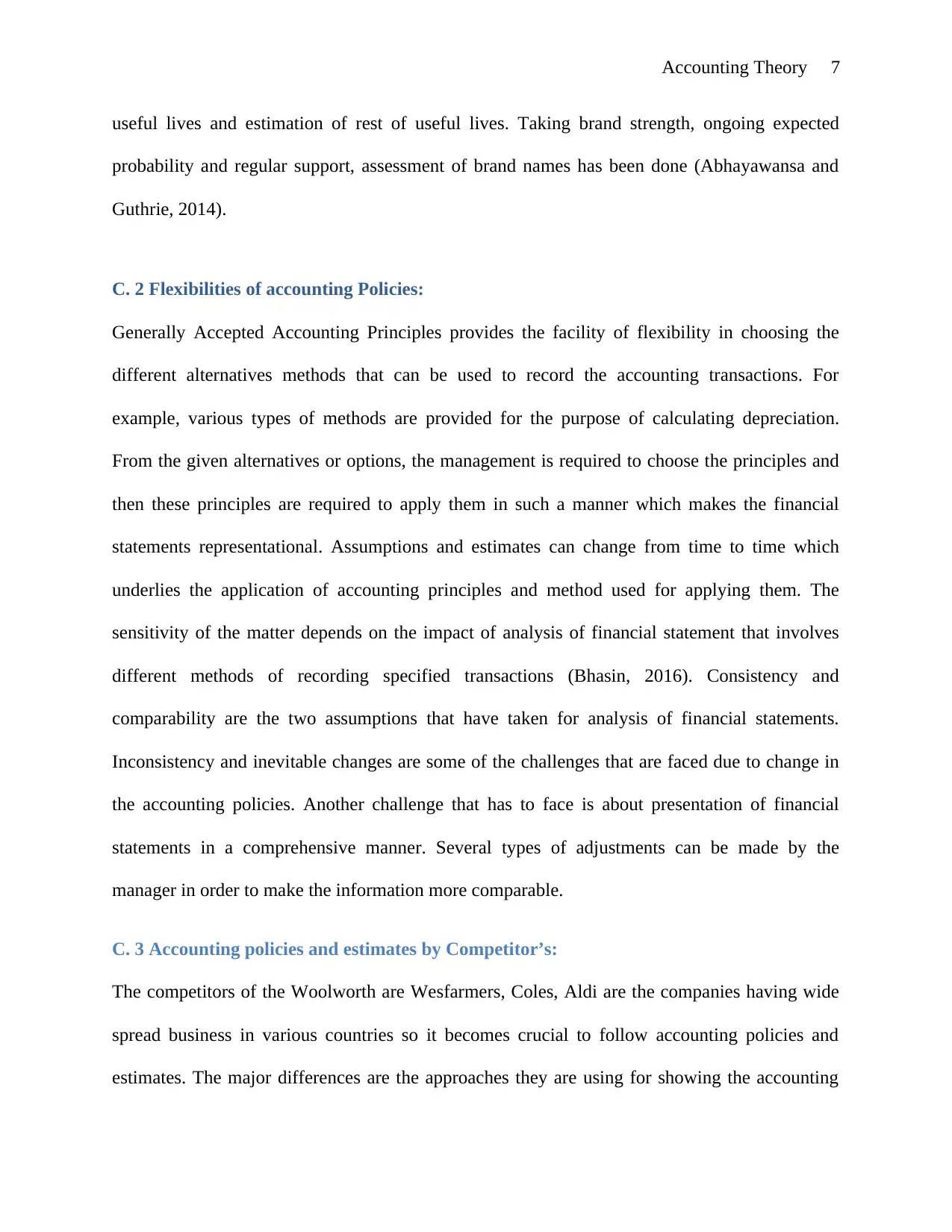
Accounting Theory 7
useful lives and estimation of rest of useful lives. Taking brand strength, ongoing expected
probability and regular support, assessment of brand names has been done (Abhayawansa and
Guthrie, 2014).
C. 2 Flexibilities of accounting Policies:
Generally Accepted Accounting Principles provides the facility of flexibility in choosing the
different alternatives methods that can be used to record the accounting transactions. For
example, various types of methods are provided for the purpose of calculating depreciation.
From the given alternatives or options, the management is required to choose the principles and
then these principles are required to apply them in such a manner which makes the financial
statements representational. Assumptions and estimates can change from time to time which
underlies the application of accounting principles and method used for applying them. The
sensitivity of the matter depends on the impact of analysis of financial statement that involves
different methods of recording specified transactions (Bhasin, 2016). Consistency and
comparability are the two assumptions that have taken for analysis of financial statements.
Inconsistency and inevitable changes are some of the challenges that are faced due to change in
the accounting policies. Another challenge that has to face is about presentation of financial
statements in a comprehensive manner. Several types of adjustments can be made by the
manager in order to make the information more comparable.
C. 3 Accounting policies and estimates by Competitor’s:
The competitors of the Woolworth are Wesfarmers, Coles, Aldi are the companies having wide
spread business in various countries so it becomes crucial to follow accounting policies and
estimates. The major differences are the approaches they are using for showing the accounting
useful lives and estimation of rest of useful lives. Taking brand strength, ongoing expected
probability and regular support, assessment of brand names has been done (Abhayawansa and
Guthrie, 2014).
C. 2 Flexibilities of accounting Policies:
Generally Accepted Accounting Principles provides the facility of flexibility in choosing the
different alternatives methods that can be used to record the accounting transactions. For
example, various types of methods are provided for the purpose of calculating depreciation.
From the given alternatives or options, the management is required to choose the principles and
then these principles are required to apply them in such a manner which makes the financial
statements representational. Assumptions and estimates can change from time to time which
underlies the application of accounting principles and method used for applying them. The
sensitivity of the matter depends on the impact of analysis of financial statement that involves
different methods of recording specified transactions (Bhasin, 2016). Consistency and
comparability are the two assumptions that have taken for analysis of financial statements.
Inconsistency and inevitable changes are some of the challenges that are faced due to change in
the accounting policies. Another challenge that has to face is about presentation of financial
statements in a comprehensive manner. Several types of adjustments can be made by the
manager in order to make the information more comparable.
C. 3 Accounting policies and estimates by Competitor’s:
The competitors of the Woolworth are Wesfarmers, Coles, Aldi are the companies having wide
spread business in various countries so it becomes crucial to follow accounting policies and
estimates. The major differences are the approaches they are using for showing the accounting
Paraphrase This Document
Need a fresh take? Get an instant paraphrase of this document with our AI Paraphraser
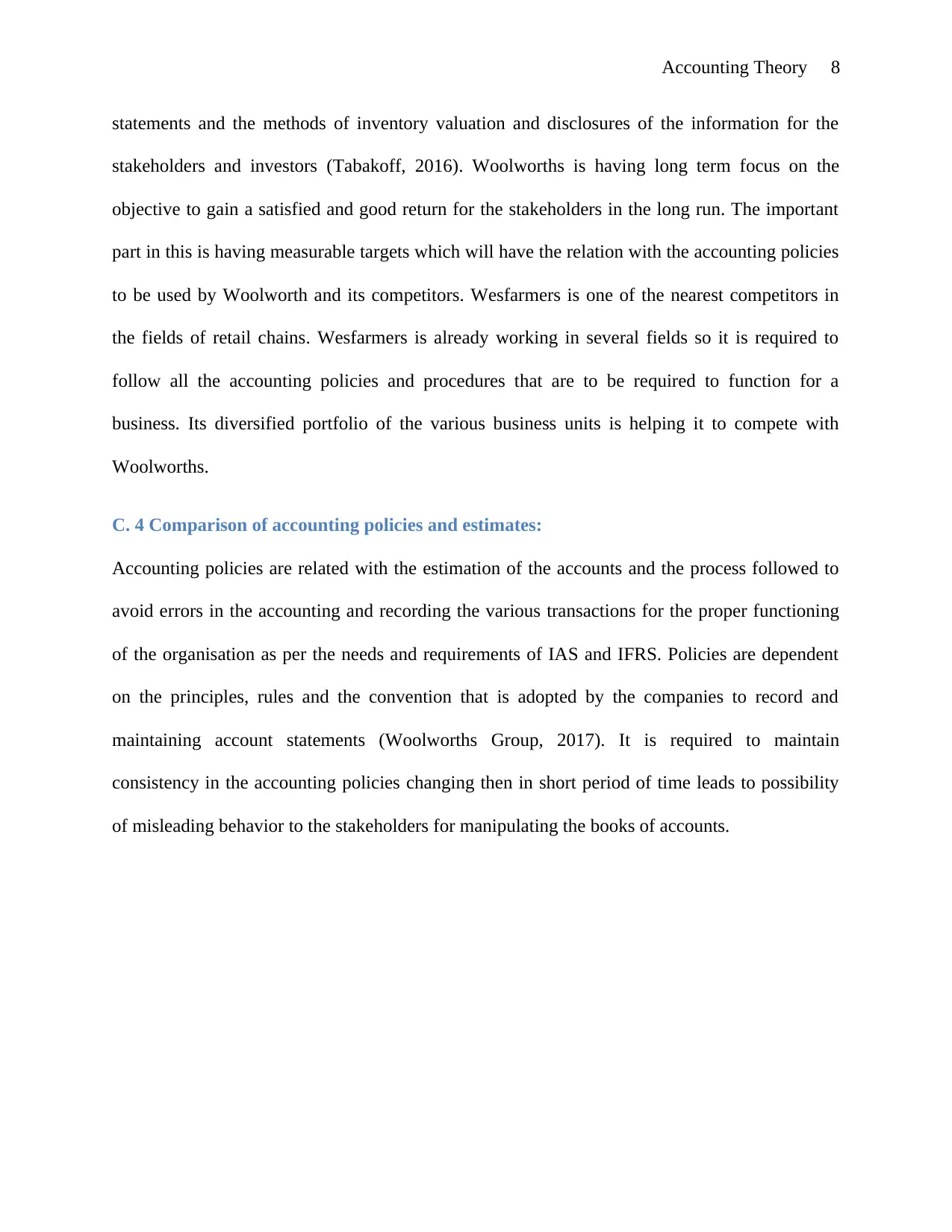
Accounting Theory 8
statements and the methods of inventory valuation and disclosures of the information for the
stakeholders and investors (Tabakoff, 2016). Woolworths is having long term focus on the
objective to gain a satisfied and good return for the stakeholders in the long run. The important
part in this is having measurable targets which will have the relation with the accounting policies
to be used by Woolworth and its competitors. Wesfarmers is one of the nearest competitors in
the fields of retail chains. Wesfarmers is already working in several fields so it is required to
follow all the accounting policies and procedures that are to be required to function for a
business. Its diversified portfolio of the various business units is helping it to compete with
Woolworths.
C. 4 Comparison of accounting policies and estimates:
Accounting policies are related with the estimation of the accounts and the process followed to
avoid errors in the accounting and recording the various transactions for the proper functioning
of the organisation as per the needs and requirements of IAS and IFRS. Policies are dependent
on the principles, rules and the convention that is adopted by the companies to record and
maintaining account statements (Woolworths Group, 2017). It is required to maintain
consistency in the accounting policies changing then in short period of time leads to possibility
of misleading behavior to the stakeholders for manipulating the books of accounts.
statements and the methods of inventory valuation and disclosures of the information for the
stakeholders and investors (Tabakoff, 2016). Woolworths is having long term focus on the
objective to gain a satisfied and good return for the stakeholders in the long run. The important
part in this is having measurable targets which will have the relation with the accounting policies
to be used by Woolworth and its competitors. Wesfarmers is one of the nearest competitors in
the fields of retail chains. Wesfarmers is already working in several fields so it is required to
follow all the accounting policies and procedures that are to be required to function for a
business. Its diversified portfolio of the various business units is helping it to compete with
Woolworths.
C. 4 Comparison of accounting policies and estimates:
Accounting policies are related with the estimation of the accounts and the process followed to
avoid errors in the accounting and recording the various transactions for the proper functioning
of the organisation as per the needs and requirements of IAS and IFRS. Policies are dependent
on the principles, rules and the convention that is adopted by the companies to record and
maintaining account statements (Woolworths Group, 2017). It is required to maintain
consistency in the accounting policies changing then in short period of time leads to possibility
of misleading behavior to the stakeholders for manipulating the books of accounts.
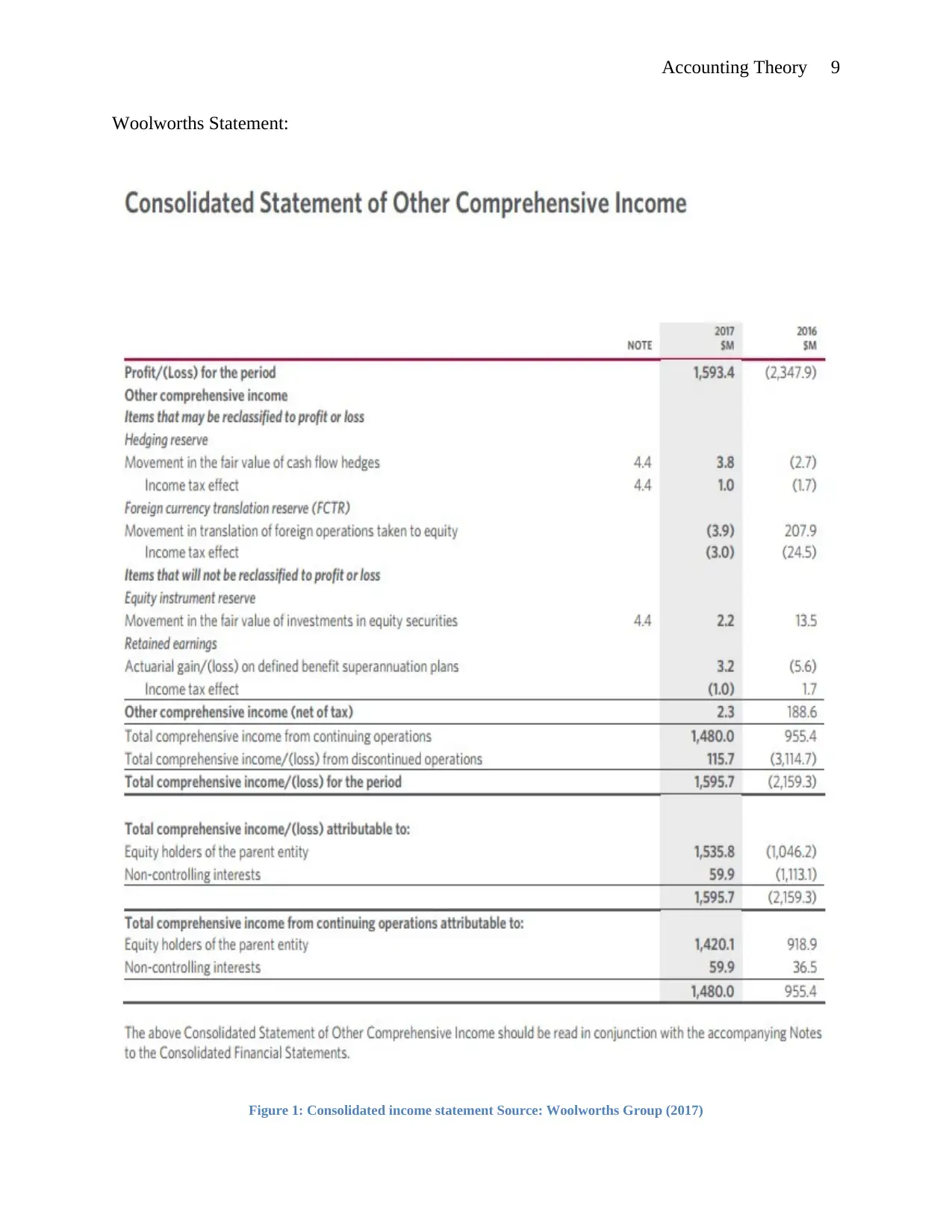
Accounting Theory 9
Woolworths Statement:
Figure 1: Consolidated income statement Source: Woolworths Group (2017)
Woolworths Statement:
Figure 1: Consolidated income statement Source: Woolworths Group (2017)
⊘ This is a preview!⊘
Do you want full access?
Subscribe today to unlock all pages.

Trusted by 1+ million students worldwide
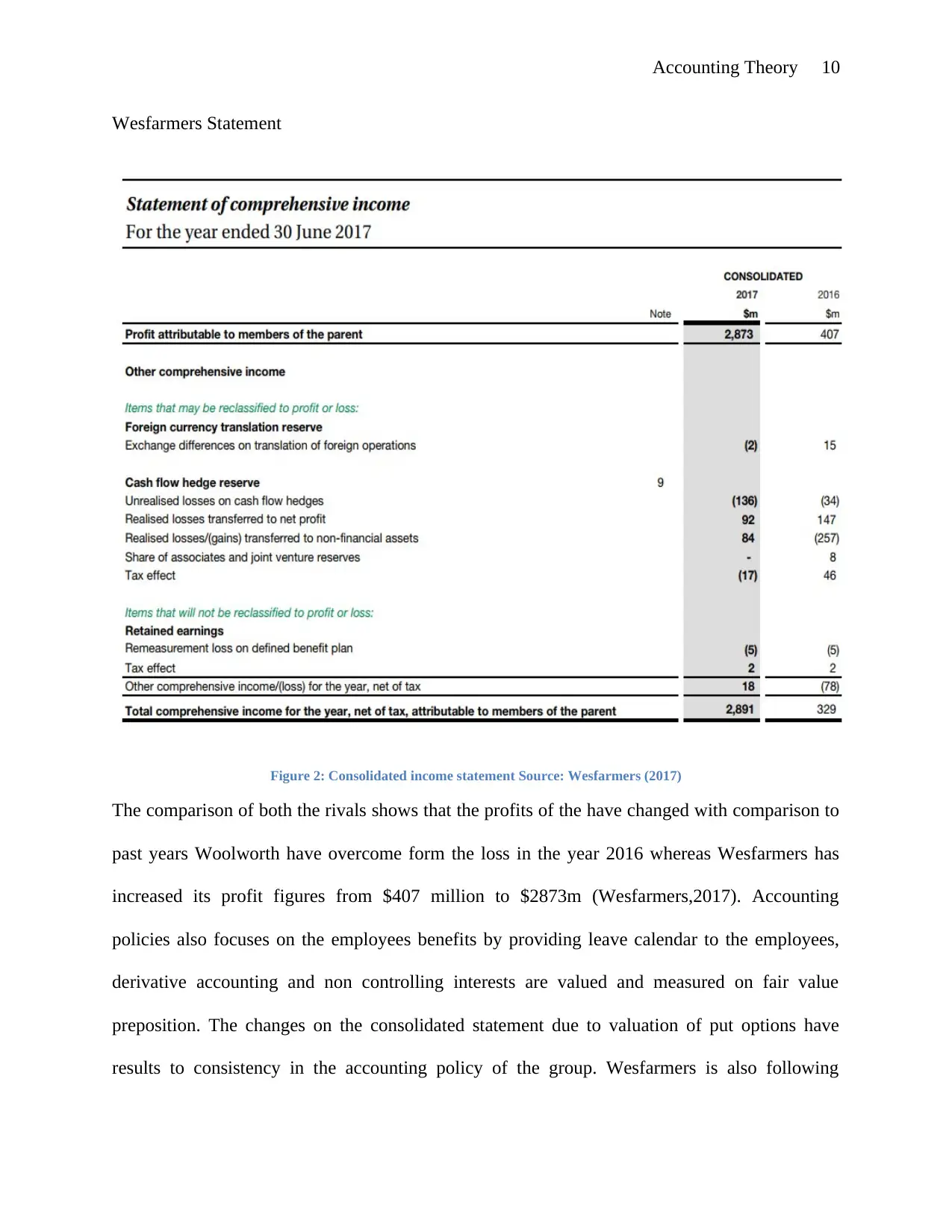
Accounting Theory 10
Wesfarmers Statement
Figure 2: Consolidated income statement Source: Wesfarmers (2017)
The comparison of both the rivals shows that the profits of the have changed with comparison to
past years Woolworth have overcome form the loss in the year 2016 whereas Wesfarmers has
increased its profit figures from $407 million to $2873m (Wesfarmers,2017). Accounting
policies also focuses on the employees benefits by providing leave calendar to the employees,
derivative accounting and non controlling interests are valued and measured on fair value
preposition. The changes on the consolidated statement due to valuation of put options have
results to consistency in the accounting policy of the group. Wesfarmers is also following
Wesfarmers Statement
Figure 2: Consolidated income statement Source: Wesfarmers (2017)
The comparison of both the rivals shows that the profits of the have changed with comparison to
past years Woolworth have overcome form the loss in the year 2016 whereas Wesfarmers has
increased its profit figures from $407 million to $2873m (Wesfarmers,2017). Accounting
policies also focuses on the employees benefits by providing leave calendar to the employees,
derivative accounting and non controlling interests are valued and measured on fair value
preposition. The changes on the consolidated statement due to valuation of put options have
results to consistency in the accounting policy of the group. Wesfarmers is also following
Paraphrase This Document
Need a fresh take? Get an instant paraphrase of this document with our AI Paraphraser
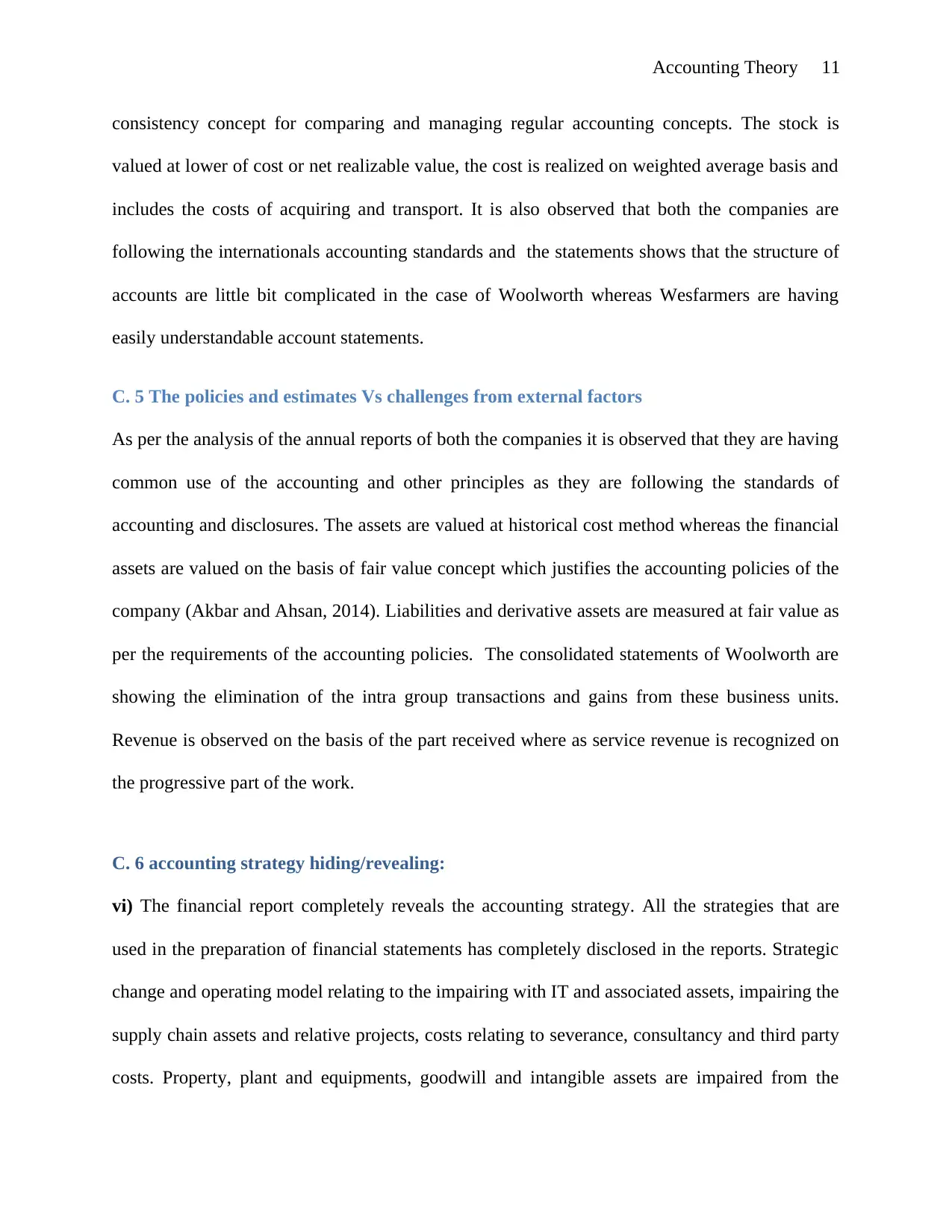
Accounting Theory 11
consistency concept for comparing and managing regular accounting concepts. The stock is
valued at lower of cost or net realizable value, the cost is realized on weighted average basis and
includes the costs of acquiring and transport. It is also observed that both the companies are
following the internationals accounting standards and the statements shows that the structure of
accounts are little bit complicated in the case of Woolworth whereas Wesfarmers are having
easily understandable account statements.
C. 5 The policies and estimates Vs challenges from external factors
As per the analysis of the annual reports of both the companies it is observed that they are having
common use of the accounting and other principles as they are following the standards of
accounting and disclosures. The assets are valued at historical cost method whereas the financial
assets are valued on the basis of fair value concept which justifies the accounting policies of the
company (Akbar and Ahsan, 2014). Liabilities and derivative assets are measured at fair value as
per the requirements of the accounting policies. The consolidated statements of Woolworth are
showing the elimination of the intra group transactions and gains from these business units.
Revenue is observed on the basis of the part received where as service revenue is recognized on
the progressive part of the work.
C. 6 accounting strategy hiding/revealing:
vi) The financial report completely reveals the accounting strategy. All the strategies that are
used in the preparation of financial statements has completely disclosed in the reports. Strategic
change and operating model relating to the impairing with IT and associated assets, impairing the
supply chain assets and relative projects, costs relating to severance, consultancy and third party
costs. Property, plant and equipments, goodwill and intangible assets are impaired from the
consistency concept for comparing and managing regular accounting concepts. The stock is
valued at lower of cost or net realizable value, the cost is realized on weighted average basis and
includes the costs of acquiring and transport. It is also observed that both the companies are
following the internationals accounting standards and the statements shows that the structure of
accounts are little bit complicated in the case of Woolworth whereas Wesfarmers are having
easily understandable account statements.
C. 5 The policies and estimates Vs challenges from external factors
As per the analysis of the annual reports of both the companies it is observed that they are having
common use of the accounting and other principles as they are following the standards of
accounting and disclosures. The assets are valued at historical cost method whereas the financial
assets are valued on the basis of fair value concept which justifies the accounting policies of the
company (Akbar and Ahsan, 2014). Liabilities and derivative assets are measured at fair value as
per the requirements of the accounting policies. The consolidated statements of Woolworth are
showing the elimination of the intra group transactions and gains from these business units.
Revenue is observed on the basis of the part received where as service revenue is recognized on
the progressive part of the work.
C. 6 accounting strategy hiding/revealing:
vi) The financial report completely reveals the accounting strategy. All the strategies that are
used in the preparation of financial statements has completely disclosed in the reports. Strategic
change and operating model relating to the impairing with IT and associated assets, impairing the
supply chain assets and relative projects, costs relating to severance, consultancy and third party
costs. Property, plant and equipments, goodwill and intangible assets are impaired from the
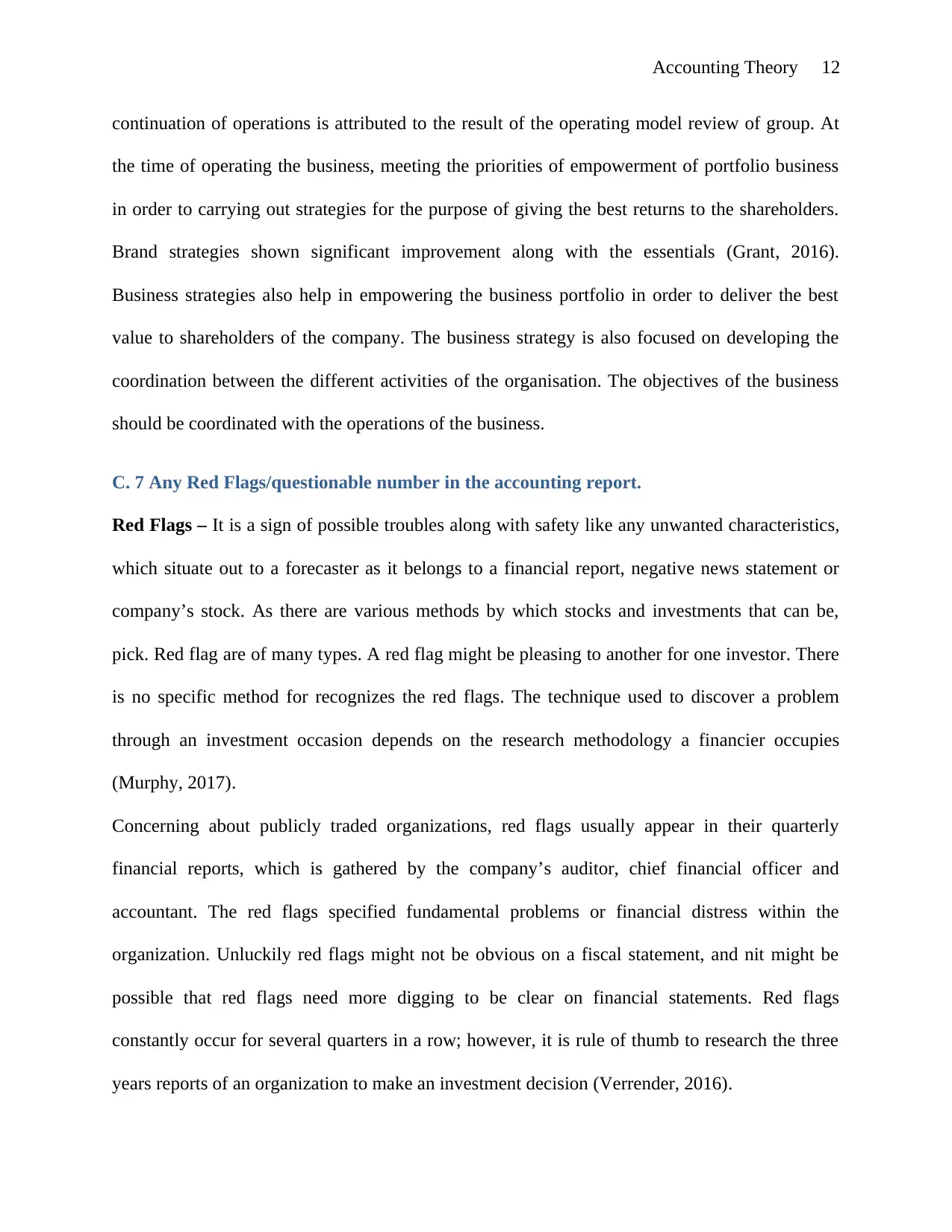
Accounting Theory 12
continuation of operations is attributed to the result of the operating model review of group. At
the time of operating the business, meeting the priorities of empowerment of portfolio business
in order to carrying out strategies for the purpose of giving the best returns to the shareholders.
Brand strategies shown significant improvement along with the essentials (Grant, 2016).
Business strategies also help in empowering the business portfolio in order to deliver the best
value to shareholders of the company. The business strategy is also focused on developing the
coordination between the different activities of the organisation. The objectives of the business
should be coordinated with the operations of the business.
C. 7 Any Red Flags/questionable number in the accounting report.
Red Flags – It is a sign of possible troubles along with safety like any unwanted characteristics,
which situate out to a forecaster as it belongs to a financial report, negative news statement or
company’s stock. As there are various methods by which stocks and investments that can be,
pick. Red flag are of many types. A red flag might be pleasing to another for one investor. There
is no specific method for recognizes the red flags. The technique used to discover a problem
through an investment occasion depends on the research methodology a financier occupies
(Murphy, 2017).
Concerning about publicly traded organizations, red flags usually appear in their quarterly
financial reports, which is gathered by the company’s auditor, chief financial officer and
accountant. The red flags specified fundamental problems or financial distress within the
organization. Unluckily red flags might not be obvious on a fiscal statement, and nit might be
possible that red flags need more digging to be clear on financial statements. Red flags
constantly occur for several quarters in a row; however, it is rule of thumb to research the three
years reports of an organization to make an investment decision (Verrender, 2016).
continuation of operations is attributed to the result of the operating model review of group. At
the time of operating the business, meeting the priorities of empowerment of portfolio business
in order to carrying out strategies for the purpose of giving the best returns to the shareholders.
Brand strategies shown significant improvement along with the essentials (Grant, 2016).
Business strategies also help in empowering the business portfolio in order to deliver the best
value to shareholders of the company. The business strategy is also focused on developing the
coordination between the different activities of the organisation. The objectives of the business
should be coordinated with the operations of the business.
C. 7 Any Red Flags/questionable number in the accounting report.
Red Flags – It is a sign of possible troubles along with safety like any unwanted characteristics,
which situate out to a forecaster as it belongs to a financial report, negative news statement or
company’s stock. As there are various methods by which stocks and investments that can be,
pick. Red flag are of many types. A red flag might be pleasing to another for one investor. There
is no specific method for recognizes the red flags. The technique used to discover a problem
through an investment occasion depends on the research methodology a financier occupies
(Murphy, 2017).
Concerning about publicly traded organizations, red flags usually appear in their quarterly
financial reports, which is gathered by the company’s auditor, chief financial officer and
accountant. The red flags specified fundamental problems or financial distress within the
organization. Unluckily red flags might not be obvious on a fiscal statement, and nit might be
possible that red flags need more digging to be clear on financial statements. Red flags
constantly occur for several quarters in a row; however, it is rule of thumb to research the three
years reports of an organization to make an investment decision (Verrender, 2016).
⊘ This is a preview!⊘
Do you want full access?
Subscribe today to unlock all pages.

Trusted by 1+ million students worldwide
1 out of 19
Related Documents
Your All-in-One AI-Powered Toolkit for Academic Success.
+13062052269
info@desklib.com
Available 24*7 on WhatsApp / Email
![[object Object]](/_next/static/media/star-bottom.7253800d.svg)
Unlock your academic potential
Copyright © 2020–2025 A2Z Services. All Rights Reserved. Developed and managed by ZUCOL.





